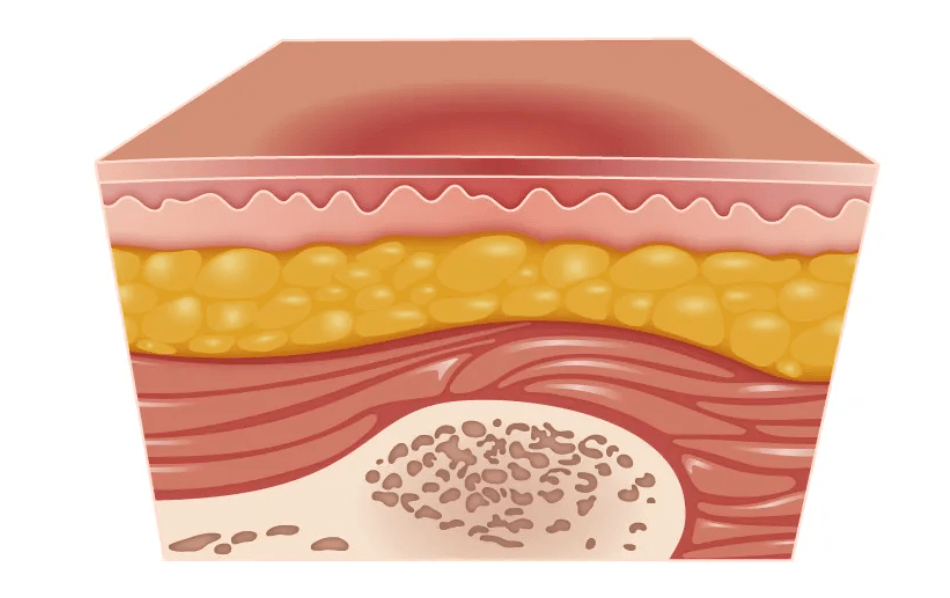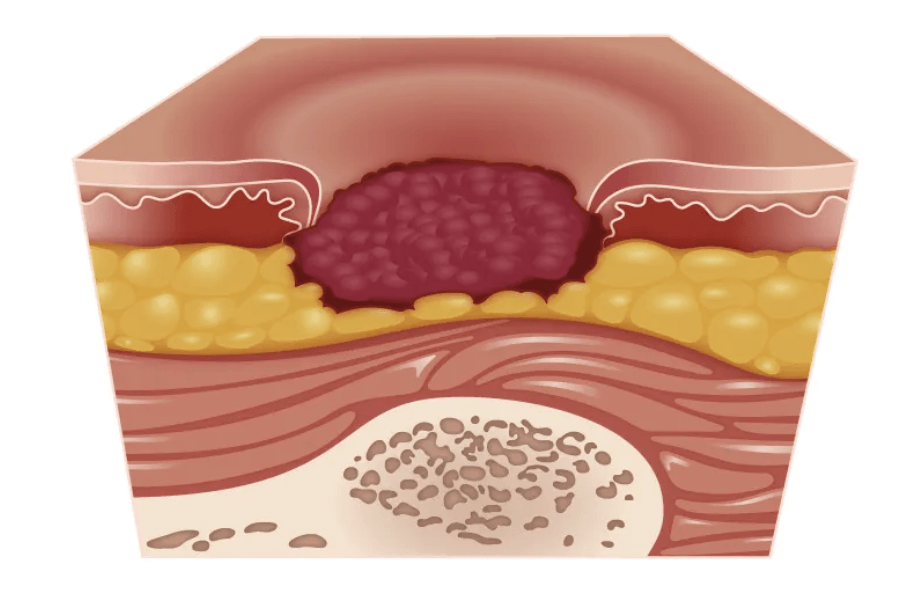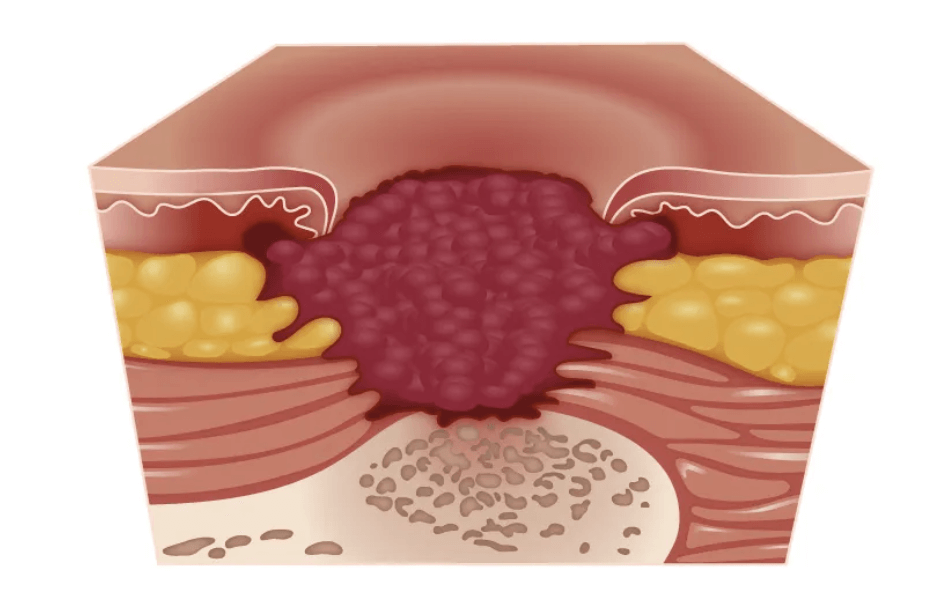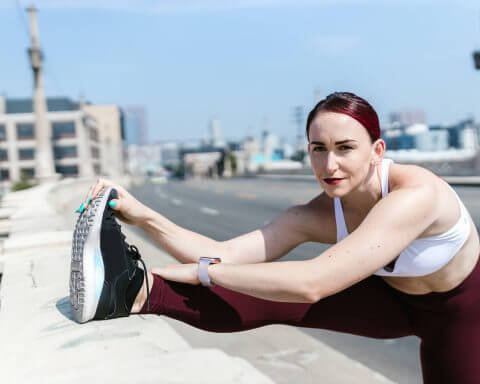This is not a very pretty or fun topic to cover. However, we feel that it is necessary to make our readers more aware of Skin Ulcers. The fact that they affect so many people – especially older populations – brings the seriousness of these conditions to the forefront.
Skin Ulcer is a wound that appears due to prolonged pressure and consequent decrease in blood circulation in a certain part of the skin.
Main Stages of Skin Ulcer
Initially, the skin ulcer appears only as a red spot, but over time this site may have a small wound that does not heal and increases in size. Depending on the time of evolution of the ulcer, it is possible to identify 4 stages:
Stage 1

In the first stage, the ulcer appears as a reddish patch that does not change its color to white or paler when pressed. The ulcer maintains this color even after the pressure has been released. In the case of black or darker skin, this stain may also have a dark or purplish coloration, instead of red.
This type of stain, in addition to being white for a long time after being pressed, can also be harder than the rest of the skin, be hot or colder than the rest of the body. The person may also refer to a tingling or burning sensation in that place.
Signs of Skin Ulcer at Stage 1
In the first stage, you will notice several signs of skin ulcer which include:
- The skin of the affected area doesn’t change its color (red)even if being pressed hard.
- You may experience pain when touching the affected area
- You will feel a burning sensation or itching in the affected area
What to do: At this stage, pressure ulcers can still be prevented and, therefore, the ideal is to keep the skin intact and improve blood circulation. For this, you should try to keep the skin as dry as possible, apply a moisturizing cream frequently, as well as avoid positions that can put pressure on the area for more than 40 minutes in a row. In addition, it is important to have regular massages on the spot to facilitate circulation and eat foods rich in calcium, iron, and protein.
Stage 2

At this stage, the first wound appears, which may be small, but appears as an opening in the skin exposing the epidermis and sometimes even the dermis. In addition to the wound, the skin in the area of the stain appears thinner and may look dry or brighter than normal. Also, you may see clear fluid in the broken skin.
Signs of Skin Ulcer at Stage 2
At stage 2 the ulcer may show signs including:
- There is some superficial skin loss, including abrasions, blisters, or both
- Swelling appears around the wound.
- You may experience increased pain
- There may be some discharge of clear fluid or pus from the ulcer
What to do: although the wound has already appeared, at this stage it is easier to stimulate healing and prevent infection. For this, it is important to go to the hospital, or a health center, so that the place is evaluated by a doctor or nurse, in order to start treatment with the most appropriate products and dressings. In addition, the pressure of the site should continue to be relieved, as well as drinking plenty of water and increasing the intake of foods rich in protein and vitamins, such as eggs or fish, as they facilitate healing.
Stage 3

In stage 3, the ulcer continues to develop and increase in size, starting to affect deeper layers of the skin (Dermis), including the subcutaneous layer, where fat deposits are found. That is why, at this stage, inside the wound, it is possible to observe a type of irregular and yellowish tissue, which is formed by fat cells.
At this stage, the depth of the ulcer varies according to the affected site and, therefore, it is normal that the subcutaneous layer cannot be seen in tendon, muscle, or bone. Also, in some cases, you can observe visible pus and an unpleasant odor that indicates that the body is susceptible to infection and leads to serious complications.
Signs of Skin Ulcer at Stage 3
Signs of stage 3 skin ulcer include:
- Damaged tissues
- Pus in the wound
- Unpleasant odor from the wound
- Redness
What to do: You must maintain the appropriate treatment with the guidance of a nurse or doctor. They may suggest you take antibiotic treatment along with the removal of dead tissues so that the healing process is improved. It is also important to drink a lot of water during the day and bet on a diet richer in protein so that new tissues are formed. In addition, the pressure of the affected areas should also continue to be relieved, and the doctor may even recommend the purchase of a mattress that varies the pressure along the body, especially in people who are bedridden for a long time.
Stage 4

This is the last stage of skin ulcer development and is characterized by the destruction of the deeper layers, where muscles, tendons, and even bones are found. In this type of ulcer, there is a high risk of infection and, therefore, the person may need to stay in the hospital to have more regular dressings and receive antibiotics directly into the vein.
Another very common feature is the presence of a very foul smell, due to tissue death and the production of secretions that can become infected.
Signs of Skin Ulcer at Stage 4
Skin ulcer at stage 4 shows signs including:
- Presence of a very foul smell
- Pus in the wound
- Production of secretions
- Extreme pain in the wound
What to do: These ulcers must be treated in the hospital and you may even need to stay in the hospital for antibiotics to prevent a possible infection. It may also be necessary to remove layers of dead tissue, and surgery may be recommended.
Frequently Asked Questions About Skin Ulcer
- What are the different types of skin ulcers?
- Arterial skin ulcers
- Decubitus (pressure) ulcers
- Neuropathic skin ulcers
- Venous skin ulcers
- What are preventions of skin ulcers?
Skin ulcers can be prevented by:
- Frequent repositioning
- Meticulous skin care and hygiene
- Keep moving
- Avoiding dehydration
- Using pressure-relieving pads over bony areas of skin





